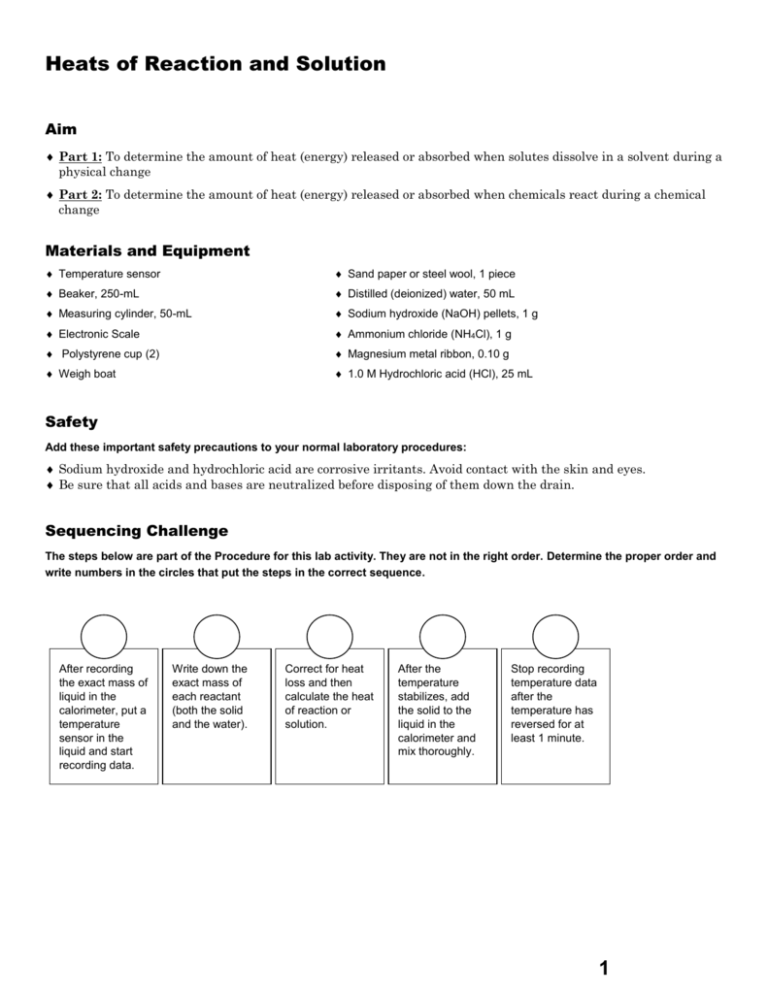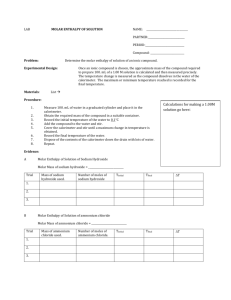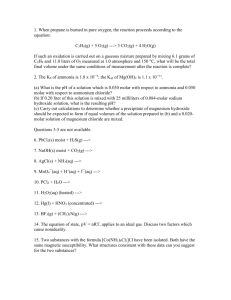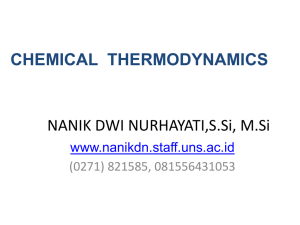Heats of Reaction and Solution
advertisement

Heats of Reaction and Solution Aim Part 1: To determine the amount of heat (energy) released or absorbed when solutes dissolve in a solvent during a physical change Part 2: To determine the amount of heat (energy) released or absorbed when chemicals react during a chemical change Materials and Equipment Temperature sensor Sand paper or steel wool, 1 piece Beaker, 250-mL Distilled (deionized) water, 50 mL Measuring cylinder, 50-mL Sodium hydroxide (NaOH) pellets, 1 g Electronic Scale Ammonium chloride (NH4Cl), 1 g Polystyrene cup (2) Magnesium metal ribbon, 0.10 g Weigh boat 1.0 M Hydrochloric acid (HCl), 25 mL Safety Add these important safety precautions to your normal laboratory procedures: Sodium hydroxide and hydrochloric acid are corrosive irritants. Avoid contact with the skin and eyes. Be sure that all acids and bases are neutralized before disposing of them down the drain. Sequencing Challenge The steps below are part of the Procedure for this lab activity. They are not in the right order. Determine the proper order and write numbers in the circles that put the steps in the correct sequence. After recording the exact mass of liquid in the calorimeter, put a temperature sensor in the liquid and start recording data. Write down the exact mass of each reactant (both the solid and the water). Correct for heat loss and then calculate the heat of reaction or solution. After the temperature stabilizes, add the solid to the liquid in the calorimeter and mix thoroughly. Stop recording temperature data after the temperature has reversed for at least 1 minute. 1 Procedure After you complete a step (or answer a question), place a check mark in the box () next to that step. Part 1 – Dissolving Sodium Hydroxide (NaOH) and Ammonium Chloride (NH4Cl) 1. Connect a temperature sensor to the data collection system and create a display of Temperature (°C) versus Time (s) on a graph. �(7.1.1) 2. Measure approximately 1.0 g of sodium hydroxide (NaOH) pellets and record the exact mass in the data table: Table 1: Data collected for dissolving sodium hydroxide in water Mass of NaOH (g) Volume of Water (mL) Mass of Water (g) 3. Measure approximately 25 mL of water using a measuring cylinder, and write the exact volume in the data table above. 4. Place a clean, dry polystyrene cup into another polystyrene cup to create a simple calorimeter. Place the calorimeter on the balance and tare the balance. 5. Pour the approximately 25 mL of water into the calorimeter. Record the mass of the water. 6. Compare the volume of the water with its mass. Is this what you would expect? Explain. ________________________________________________________________________________________________________ ________________________________________________________________________________________________________ 7. Place the calorimeter containing the 25 mL of water into a 250-mL beaker. 8. Place the temperature sensor in the water that is in the calorimeter and start recording data. �(6.2) 9. Once the temperature stabilizes, add the solid NaOH to the water, and continuously stir the mixture until the NaOH completely dissolves. This may take several minutes. Note: You may need to adjust the scale of the axes to see the changes taking place. �(7.1.2) 10. Stop recording data once the temperature has decreased for at least one minute after reaching its maximum temperature. �(6.2) Name the data run “NaOH”. �(8.2) 11. Dispose of the NaOH solution into a waste container. Clean and thoroughly dry the calorimeter, and temperature sensor. Describe why this step is necessary. ____________________________________________________________________________________________ 12. Repeat the steps above, this time substituting ammonium chloride (NH4Cl). Take into account the following differences when you repeat the steps: 2 Use approximately 1.0 g of ammonium chloride and approximately 25 mL of water. Record the exact data values collected in the table below. Stop recording data when the temperature has increased for one minute or longer after reaching its minimum temperature. �(6.2) Name the data run “NH4Cl”. �(8.2) Table 2: Data collected for dissolving ammonium chloride in water Mass of NH4Cl (g) Volume of Water (mL) Mass of Water (g) 13. Dispose of the NH4Cl solution in a waste beaker. Thoroughly clean and dry the calorimeter, temperature sensor, and stir rod. Part 2 – Reacting Magnesium Metal and Hydrochloric Acid 14. Cut a piece of magnesium ribbon 7- to 8-cm long (approximately 0.1 g). Use sandpaper or steel wool to remove any magnesium oxide that has formed on the magnesium ribbon. 15. Measure the mass and record it in the data table below. Table 3: Data collected for reacting magnesium metal and hydrochloric acid Mass of Magnesium Metal (g) Volume of 1.0 M HCl (mL) Mass of 1.0 M HCl (g) 16. Measure approximately 25 mL of 1.0 M hydrochloric acid (HCl) using a graduated cylinder. Record the exact volume in the data table above. 17. Place a clean, dry calorimeter on the balance and tare the balance. 18. Pour the approximately 25 mL of 1.0 M HCl into the calorimeter. Record the mass of the HCl in the data table above. 19. Why is a polystyrene cup used as the calorimeter instead of a beaker? Why is the polystyrene cup placed inside the beaker? ________________________________________________________________________________________ 20. Start recording data. �(6.2) Once the temperature is stabilized, add the magnesium ribbon, and stir until the magnesium has completely reacted. The reaction may take several minutes to occur. 21. Stop recording data once the temperature has decreased for at least one minute after reaching its maximum temperature. �(6.2) Save and name the data run “Mg”. �(8.2) 22. Record any observations you witnessed that suggest a chemical reaction occurred. ________________________________________________________________________________________ Data Analysis 1. Determine the initial temperature Tinitial, the highest temperature actually attained Tfinal, actual, and the temperature that would have been reached if there was no heat lost to the surroundings Tfinal, corrected for each run of data collected. Follow the steps below to do this on your data collection system. a. Display the run of data you want to analyze. �(7.1.7) b. Find the initial temperature and the highest temperature actually attained by finding the coordinates at each of these points on the graph. �(9.1) c. Record the initial and final (actual) temperatures in Table 4 below. d. Select all the data points that were collected after the highest (including the highest temperature). e. Apply a linear fit to these selected data points. f. �(9.5) Adjust the scale of the graph so that you can find the point where the linear fit line crosses an imaginary vertical line extending up from the initial temperature. �(7.1.2) g. Record the final corrected temperature in Table 4 below. Sample Graph Extrapolation at the Same Rate of Cooling to Find the Final Corrected Temperature Tfinal, corrected Tfinal Change in temperature Tinitial Table 4: Initial, final actual, and final corrected temperature values Dissolving Sodium Hydroxide Dissolving Ammonium Chloride Reacting Magnesium Metal with Hydrochloric Acid Tinitial (˚C) Tinitial (˚C) Tinitial (˚C) Tfinal, actual (˚C) Tfinal, actual (˚C) Tfinal, actual (˚C) Tfinal, corrected (˚C) Tfinal, corrected (˚C) Tfinal, corrected (˚C) 4 �(7.1.4) 2. Determine the change in temperature for each process by subtracting the initial temperature from the final corrected temperature. Show your work and record you answers in Table 5 below. Table 5: Change in temperature Process Show Your Work Tfinal, corrected – Tinitial (°C) Change in Temperature ΔT (°C) Dissolving sodium hydroxide Dissolving ammonium chloride Reacting magnesium & HCl 3. Calculate the heat absorbed by the solution in each process, q, by using the formula given below. Convert joules to kilojoules in your final answer (÷1000). Record your answers in Table 6 below. q = m × c × ΔT, where: q = heat lost or gained by the solution m = total mass of the solution c = the specific heat of the solution (use the specific heat of water, 4.18 J/(g°C) ΔT = Tfinal, corrected – Tinitial Table 6: Heat absorbed by the solution in each process Process Show Your Work here: Heat q (kJ) Dissolving sodium hydroxide Dissolving ammonium chloride Reacting magnesium metal with hydrochloric acid 4. Find the molar enthalpy for each substance. Show your work and record your answers in Table 7 below. molar enthalpy of solution/reaction H moles of substance Note: The amount of heat absorbed or released by the solution is the opposite of the amount of heat absorbed or released by the process. ΔH = –q Table 7: Molar enthalpy for each substance Process Calculate Number of Moles (Show your work) ∆H (kJ) Calculate Molar Enthalpy, ∆H /mol (kJ/mol) Sodium hydroxide Ammonium chloride Magnesium in HCl 5. Create a graph with all three runs of data displayed on your data collection system. �(7.1.3) 6. Sketch or print a copy of your Temperature (°C) versus Time (s) graph with all three data runs on one set of axes. Label each data run as well as the overall graph, the x-axis, the y-axis, and include units on the axes. �(11.2) 6 Analysis Questions 1. Determine the percent error for each process using the following known values: percent error accepted value experimental value accepted value Process Accepted ∆H /mol (kJ/mol) Molar heat of solution for sodium hydroxide –44.5 Molar heat of solution for ammonium chloride 14.8 Molar heat of reaction for magnesium with hydrochloric acid 100 Percent Error (show work) –462.0 2. Suggest possible changes to the experimental procedure that could improve the accuracy of the results. ________________________________________________________________________________________________________ ________________________________________________________________________________________________________ 3. Why was it necessary to correct the final temperature reached? ________________________________________________________________________________________________________ ________________________________________________________________________________________________________ 4. Identify each process as exothermic or endothermic, and state your evidence in each case. Process Dissolving sodium hydroxide Dissolving ammonium chloride Reacting magnesium metal with hydrochloric acid Endothermic or Exothermic? Evidence 5. Write thermochemical equations use your experimentally determined values for molar heat of reaction or solution. Be sure to include state symbols for all reactants and products. Synthesis Questions Use available resources to help you answer the following questions. 1. Draw a diagram that illustrates what happens at the molecular level to sodium hydroxide when it is dissolved in water. 2. Heat was either released or absorbed in all three processes, but only one of the processes was a chemical reaction. Explain how this is possible. ________________________________________________________________________________________________________ ________________________________________________________________________________________________________ 3. Describe what would have happened if the physical and chemical processes were performed at 50 °C instead of room temperature? ________________________________________________________________________________________________________ ________________________________________________________________________________________________________ Multiple Choice Questions Select the best answer or completion to each of the questions or incomplete statements below. 1. Heat of reaction refers to A. B. C. D. 8 the heat released by a chemical reaction the heat absorbed by a chemical reaction The temperature of the solution after a chemical reaction occurs Both A and B 2. Using the chemical equation below, determine the energy released by burning 2 moles of propane (C3H8)? C3H8(g) + 5O2(g) → 3CO2(g) + 4H2O(l) + 2219.2 kJ A. 2219.2 kJ B. C. 4438.4 kJ 1109.6 kJ D. 11096 kJ Use the information to answer Multiple Choice Questions 3 to 5. Two grams of salt A were added to 50 mL of water, and the initial and final temperatures were recorded. In a separate experiment, 2 g of salt B were added to 50 mL of water, and the initial and final temperatures were recorded. Table 8: Temperature data for Salt A and Salt B. Salt A Salt B Initial Temperature 20 ˚C Initial Temperature 20 ˚C Final Temperature 35 ˚C Final Temperature 10 ˚C 3. What can be said about flow of energy in the two separate experiments? A. B. C. D. A: the energy flows from the water to the salt; B: the energy flows from the water to the salt A: the energy flows from the salt to the water; B: the energy flows from the salt to the water A: the energy flows from the salt to the water; B: the energy flows from the water to the salt A: the energy flows from the water to the salt; B: the energy flows from the salt to the water 4. What type of process occurred when salt A dissolved in water? A. Enthalpy B. Heat C. Endothermic D. Exothermic 5. Which equation illustrates the process that occurred when salt B dissolved in water? A. salt B(s) salt B(aq) + heat C. salt B(s) + heat salt B(aq) B. salt B(aq) salt B(aq) + heat D. salt B(aq) + heat salt B(aq) Key Term Challenge Physical changes and chemical reactions both may be accompanied by changes in ____________, often in the form of heat or ____________. Chemical and physical processes that absorb heat from their surroundings are ____________, while those that release heat into their surroundings are ____________. The energy released or absorbed by different physical and chemical processes comes from the different internal energies of the starting substances and ending substances. In exothermic processes, the starting materials have ____________ internal energy than the ____________. In endothermic processes, the ____________ are lower in energy than the ending substances. In chemical reactions, the amount of energy released per mole of material reacted is the molar ________________________ of that material. Different physical processes have different names for the heat that is released based on the process that is taking place. For example, the amount of energy released per mole of material that is melting is called the molar heat of fusion. The amount of heat released per mole of substance being dissolved is called molar ________________________. The molar heat of any physical or chemical process can be calculated by multiplying the change in ________________________, the mass of the ________________________, and the specific heat capacity of the solvent all divided by the ________________________ of substance used. Exothermic processes have ________________________ heats of reaction/solution while endothermic processes have _______________________ heats of reaction/solution.








